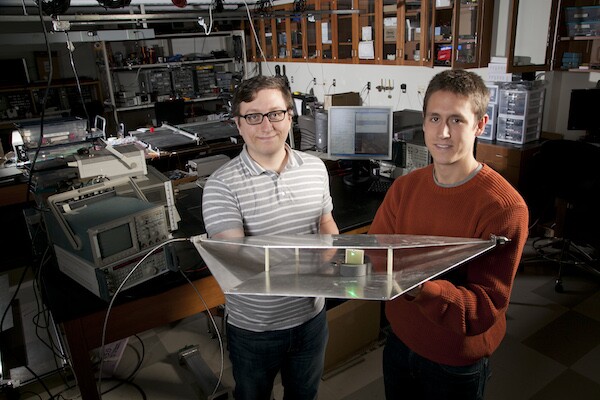Joining the ranks of devices designed to harvest energy from ambient electromagnetic radiation comes an electrical circuit from researchers at Duke University that can be tuned to capture microwave energy from various sources, including satellite, sound or Wi-Fi signals. The researchers say the device converts otherwise lost energy into direct current voltage with efficiencies similar to that of current solar cells.
Duke University students Allen Hawkes and Alexander Katko, working with lead investigator and Duke professor of electrical and computer engineering Steven Cummer, built the device using five fiberglass and copper energy conductors wired up to a circuit board to form a five-cell metamaterial array. The team says the resulting electrical circuit is able to harvest microwaves and convert them into 7.3 V of electrical energy. They compare this to USB chargers for mobile devices that provide around 5 V of power.

“We were aiming for the highest energy efficiency we could achieve,” says Hawkes. “We had been getting energy efficiency around six to 10 percent, but with this design we were able to dramatically improve energy conversion to 37 percent, which is comparable to what is achieved in solar cells.”
In addition to microwaves, the researchers say the metamaterial array could be tuned to harvest power from a range of frequencies, as well as vibrations and sound waves.
“Until now, a lot of work with metamaterials has been theoretical,"says Katko. "We are showing that with a little work, these materials can be useful for consumer applications. The properties of metamaterials allow for design flexibility not possible with ordinary devices like antennas. When traditional antennas are close to each other in space they talk to each other and interfere with each other’s operation. The design process used to create our metamaterial array takes these effects into account, allowing the cells to work together.”
Katko also suggests that a metamaterial coating could be applied to the ceiling of a room to harvest Wi-Fi signals or recover otherwise lost power from home appliances to improve their energy efficiency. But one of the most attractive potential uses would be to embed the energy-harvesting metamaterial in a mobile phone. The researchers say this could be accomplished with some modifications to the technology and provide people in remote locations with the ability to harvest energy from a mobile phone tower.
“Our work demonstrates a simple and inexpensive approach to electromagnetic power harvesting,” says Cummer. “The beauty of the design is that the basic building blocks are self-contained and additive. One can simply assemble more blocks to increase the scavenged power.”
In this way, a series of blocks could be set up to harvest energy from satellites passing overhead. Although this wouldn't yield a large amount of power, the researchers say it could be enough to a remote sensor network used for infrequent data collection in remote locations.
The team's power-harvesting device is detailed in a paper in the journal Applied Physics Letters.
Source: Duke University





